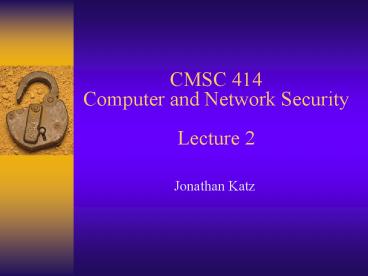CMSC 414 Computer and Network Security Lecture 2 - PowerPoint PPT Presentation
1 / 26
Title:
CMSC 414 Computer and Network Security Lecture 2
Description:
I may simplify, but I will try not to say anything that is an outright lie... E-cash (e.g., double spending) General secure multi-party computation. Anonymity ... – PowerPoint PPT presentation
Number of Views:48
Avg rating:3.0/5.0
Title: CMSC 414 Computer and Network Security Lecture 2
1
CMSC 414Computer and Network SecurityLecture 2
- Jonathan Katz
2
JCE tutorial
- In class next Tuesday
3
A high-level survey of cryptography
4
Caveat
- Everything I present will be (relatively)
informal - I may simplify, but I will try not to say
anything that is an outright lie - Cryptography is about precise definitions, formal
models, and rigorous proofs of security (which we
will not cover here) - For more details, take CMSC 456 with me (or read
my book)!
5
Goals of cryptography
- Crypto deals primarily with three goals
- Confidentiality
- Integrity (of data)
- Authentication (of resources, people, systems)
- Other goals also considered
- E.g., non-repudiation
- E-cash (e.g., double spending)
- General secure multi-party computation
- Anonymity
6
Private- vs. public-key settings
- For the basic goals of confidentiality and
integrity, there are two settings - Private-key / shared-key / symmetric-key /
secret-key - Public-key
- The private-key setting is the classical one
(thousands of years old) - The public-key setting dates to the 1970s
7
Private-key cryptography
- The communicating parties share some information
that is random and secret - This shared information is called a key
- Key is not known to an attacker
- This key must be shared (somehow) in advance of
their communication
8
To emphasize
- Alice and Bob share a key K
- Must be shared securely
- Must be completely random
- Must be kept completely secret from attacker
- We dont discuss (for now) how they do this
- You can imagine they meet on a dark street corner
and Alice hands a USB device (with a key on it)
to Bob
9
Private-key cryptography
- For confidentiality
- Private-key (symmetric-key) encryption
- For data integrity
- Message authentication codes
- (archaic cryptographic checksums)
10
Canonical applications
- Two (or more) distinct parties communicating over
an insecure network - E.g., secure communication
- A single party who is communicating with itself
over time - E.g., secure storage
11
K
shared info
K
12
(No Transcript)
13
Security?
- We will specify the exact threat model being
addressed - We will also specify the security guarantees that
are ensured, within this threat model - Here informally CMSC 456 formally
- Crucial to understand these issues before crypto
can be successfully deployed! - Make sure the stated threat model matches your
application - Make sure the security guarantees are what you
need
14
Security through obscurity?
- Always assume that the full details of crypto
protocols and algorithms are public - Known as Kerckhoffs principle
- Only secret information is a key
- Security through obscurity is a bad idea
- True in general even more true in the case of
cryptography - Home-brewed solutions are BAD!
- Standardized, widely-accepted solutions are GOOD!
15
Private-key encryption
16
Functional definition
- Encryption algorithm
- Takes a key and a message (plaintext), and
outputs a ciphertext - c ? EK(m)
- Decryption algorithm
- Takes a key and a ciphertext, and outputs a
message (or perhaps an error) - m DK(c)
- Correctness for all K, we have DK(EK(m)) m
- We have not yet said anything about security
17
K
shared info
K
c
c?EK(m)
mDK(c)
18
A classic example shift cipher
- Assume the English uppercase alphabet (no
lowercase, punctuation, etc.) - View letters as numbers in 0, , 25
- The key is a random letter of the alphabet
- Encryption done by addition modulo 26
- Is this secure?
- Exhaustive key search
- Automated determination of the key
19
Another example substitution cipher
- The key is a random permutation of the alphabet
- Note key space is huge!
- Encryption done in the natural way
- Is this secure?
- Frequency analysis
- A large key space is necessary, but not
sufficient, for security
20
Another example Vigenere cipher
- More complicated version of shift cipher
- Believed to be secure for over 100 years
- Is it secure?
- Index of coincidence method
21
Moral of the story?
- Dont use simple schemes
- Dont use schemes that you design yourself
- Use schemes that other people have already
designed and analyzed
22
A fundamental problem
- A fundamental problem with classical
cryptography is that no definition of security
was ever specified - It was not even clear what it would mean for an
encryption scheme to be secure - As a consequence, proving security was not even
an option - So how can you know when something is secure?
23
Defining security?
- What is a good definition?
24
Security goals?
- Adversary unable to recover the key
- Necessary, but meaningless on its own
- Adversary unable to recover entire plaintext
- Good, but is it enough?
- Adversary unable to determine any information at
all about the plaintext - Formalize?
- Sounds great!
- Can we achieve it?
25
Note
- Even given our definition, we need to consider
the threat model - Multiple messages or a single message?
- Passive/active adversary?
- Chosen-plaintext attacks?
26
Next time the one-time pad its
limitations overcoming these limitations































